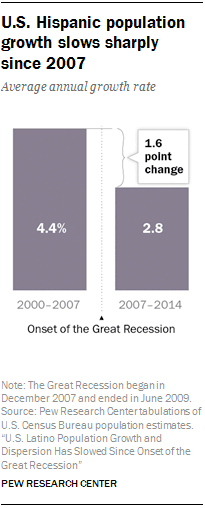U.S. Latino Population Growth and Dispersion Has Slowed [REPORT]
September 15, 2016
![]() By Renee Stepler and Mark Hugo Lopez
By Renee Stepler and Mark Hugo Lopez
The nation’s Latino population has long been characterized by its rapid growth and by its wide dispersion to parts of the country that traditionally have had few Latinos. But a new Pew Research Center analysis of U.S. Census Bureau data finds that the growth and dispersion of the U.S. Latino population has slowed since 2007, when the Great Recession started, immigration from Latin America cooled and Latino fertility rates began to fall.
 Between 2007 and 2014, the U.S. Hispanic population grew annually on average by 2.8% (its pace of growth has been an even slower 2.4% between 2010 and 2014). This was down from a 4.4% growth rate between 2000 and 2007 and down from 5.8% annually in the 1990s. As a result, the Hispanic population, once the nation’s fastest growing, has now slipped behind Asians (whose population grew at an average annual rate of 3.4% from 2007 to 2014) in its growth rate.
Between 2007 and 2014, the U.S. Hispanic population grew annually on average by 2.8% (its pace of growth has been an even slower 2.4% between 2010 and 2014). This was down from a 4.4% growth rate between 2000 and 2007 and down from 5.8% annually in the 1990s. As a result, the Hispanic population, once the nation’s fastest growing, has now slipped behind Asians (whose population grew at an average annual rate of 3.4% from 2007 to 2014) in its growth rate.
This slowdown has been driven by two, large demographic trends affecting the Hispanic community. Immigration, which in the 1980s and 1990s was the principal driver of Hispanic population growth, began to slow in the mid-2000s. And, in the case of Mexico, immigration has now reversed back toward Mexico since 2009. As a result, the main driver of Hispanic population growth shifted to U.S. births. But here too, change is underway: Throughout much of the early 2000s birth rates of Hispanic women ages 15 to 44 were about 95 births per 1,000 women, reaching a peak of 98.3 in 2006. However, since the onset of the Great Recession, their birth rates have declined, steadily falling to 72.1 births per 1,000 Hispanic women ages 15 to 44 in 2014.
General population growth and economic opportunities in places that traditionally had few Latinos led to the dispersal of the Latino population across the U.S. beginning in the 1990s, just as Latino population growth was accelerating. 1 In the 1990s, North Carolina led in Latino population growth as new immigrant arrivals and their families moved there to pursue job opportunities in agriculture and manufacturing. In the 2000s, counties in Georgia saw some of the fastest growth nationally in their Latino populations. By 2014, a record 1,579 counties (about half of all U.S. counties) had at least 1,000 Latinos, up from just 833 in 1990. Overall, these 1,579 counties in 2014 contained 99% of the U.S. Latino population.
To download report, CLICK HERE.





























